|
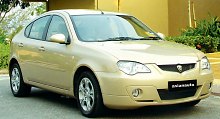 Gen.2
is a car Proton desperately needed. Since the first Proton was born in
1985, the Malaysian car maker has been relying on national
protectionism
for survival. Its model lineup consisted of many Mitsubishi-based cars
using engines and gearboxes supplied by the Japanese firm. These cars
were
outdated and made of poor quality. But Proton still dominates the
domestic
market because it is owned by the family of ex-prime minister Mahathir
Mohamad and Petronas, the nation-owned oil company. However, recently
there
are signs that the new government is going to reduce car tariff and
other
protectionism measures against imports as Malaysia is migrating to the
world of free trade. Proton is really under pressure. To survive, it
needs
to improve its competitiveness as quickly as possible. Gen.2
is a car Proton desperately needed. Since the first Proton was born in
1985, the Malaysian car maker has been relying on national
protectionism
for survival. Its model lineup consisted of many Mitsubishi-based cars
using engines and gearboxes supplied by the Japanese firm. These cars
were
outdated and made of poor quality. But Proton still dominates the
domestic
market because it is owned by the family of ex-prime minister Mahathir
Mohamad and Petronas, the nation-owned oil company. However, recently
there
are signs that the new government is going to reduce car tariff and
other
protectionism measures against imports as Malaysia is migrating to the
world of free trade. Proton is really under pressure. To survive, it
needs
to improve its competitiveness as quickly as possible.
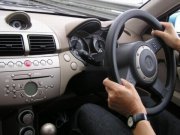 It
seems that many years ago Proton already realized the need for standing
on its own feet. In 1996, it bought Lotus to transfer the know-how of
engineering
cars. In 2001, Proton created its first car, Waja (overseas called
"Impian").
However, the car was actually mostly the work of Lotus. Its chassis was
engineered by Lotus, engines bought from Mitsubishi and Renault,
gearbox
by Mitsubishi… hardly called a self-developed model. The car's handling
and ride are merited by Lotus, but its poor quality standard and ugly
look
did not attract many customers outside homeland. It
seems that many years ago Proton already realized the need for standing
on its own feet. In 1996, it bought Lotus to transfer the know-how of
engineering
cars. In 2001, Proton created its first car, Waja (overseas called
"Impian").
However, the car was actually mostly the work of Lotus. Its chassis was
engineered by Lotus, engines bought from Mitsubishi and Renault,
gearbox
by Mitsubishi… hardly called a self-developed model. The car's handling
and ride are merited by Lotus, but its poor quality standard and ugly
look
did not attract many customers outside homeland.
Now here comes
the second
attempt - Gen.2. At the first glance, its modern, pretty look has
already
changed your view on Proton, letting you think, "Ah! this is finally a
world-class Proton !" doesn't it look like a Seat Leon? although the
styling
director was said to be a Malaysian, I guess it might be actually
penned
by Lotus designer Julian Thompson or Russell Carr. This is a shape that
most people will love.
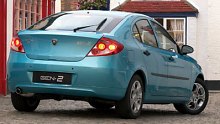 Proton
said the interior is by Lotus. Again, it is a nice design, with sporty
twin-dial instrument panel and a stylish, alloy-effect center console.
Unfortunately, the build quality and ergonomics are not as good. We'll
leave that in the latter half of this report. Proton
said the interior is by Lotus. Again, it is a nice design, with sporty
twin-dial instrument panel and a stylish, alloy-effect center console.
Unfortunately, the build quality and ergonomics are not as good. We'll
leave that in the latter half of this report.
The Gen.2 is
positioned under
Waja. However, both cars are actually very close in market positioning
because they share the same chassis and even the 2600mm wheelbase. The
biggest difference is that the Waja is a sedan while Gen.2 is a
hatchback.
Sharing
chassis
means development
time is cut by 40%. It also means the Gen.2 handles and rides as good
as
Waja. The Lotus-developed strut and multi-link suspensions give Gen.2
remarkable
body control. Minimal body roll during cornering gives it a sporty
feel.
The damping is quite firm, firmer than the Waja, but except on the
roughest
surfaces the ride is not uncomfortable.
Unfortunately,
for cheaper
price Gen.2 chooses a set of poor tires. They run out of grip easily,
ruining
an otherwise capable cornering ability. The chassis could take on much
higher g-force, but the tires just give up and turn the Gen.2 into
terminal
understeer. You cannot find such a stupid mistake in other
well-established
car makers.
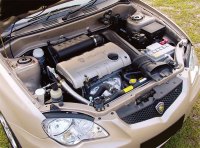 Comparatively,
the engine is better. Gen.2 gets a new, self-manufactured CAMPRO
four-cylinder
engine instead of the old Mitsubishi engine. This engine is not only
better
but also 40% cheaper than purchasing from Mitsubishi. Proton invested
US$130
million into the engine program. It was designed by Lotus as a modular
engine family. The first version used by Gen.2 is a 1.6-litre, with
iron
block, alloy head, twin-cam 16 valves to produce a remarkable 110hp and
109lbft. In the future, a variable valve timing version will join the
range.
In fact, the word "CAMPRO" stands for Cam Profile switching
technology. Comparatively,
the engine is better. Gen.2 gets a new, self-manufactured CAMPRO
four-cylinder
engine instead of the old Mitsubishi engine. This engine is not only
better
but also 40% cheaper than purchasing from Mitsubishi. Proton invested
US$130
million into the engine program. It was designed by Lotus as a modular
engine family. The first version used by Gen.2 is a 1.6-litre, with
iron
block, alloy head, twin-cam 16 valves to produce a remarkable 110hp and
109lbft. In the future, a variable valve timing version will join the
range.
In fact, the word "CAMPRO" stands for Cam Profile switching
technology.
Compare
with the
old Mitsubishi
engine, the CAMPRO 1.6-litre is more eager at high rev. However,
despite
of the claim that 85% maximum torque is available from 2500rpm, in
reality
it needs to be rev hard to deliver decent performance. And that is the
problem, because the engine is harsh and noisy at high rev, not as
refined
as the products from Ford, PSA or Opel (which was also engineered by
Lotus).
Part of the problem is because of the insufficient sound insulation
used
throughout the cabin. Not only engine noise, but wind noise, suspension
noise and tire noise are also pronounced. Normally, it is this kind of
NVH suppression separates a well-engineered car from a cheap one.
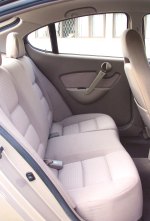 Another
area to judge a car good or bad is build quality. And the Gen.2 fails
this
test completely. From the exterior body panels you can already see
misalignment,
large and varying assembly gaps. This won't appear in other cars, even
the cheapest Korean cars. The Korean has improved vastly in recent
years,
but Proton's quality standard still remains in the 1980s level. Enter
the
cabin and the impression deteriorates - nasty hard plastics are used
throughout
the cabin. Rough edges everywhere. Filmsy cupholders and hinges of
center
bin lid are likely to break easily. When the car rides on bumps, the
loosely
fitted parts work in harmony to squeak, letting you doubt whether the
car
is tightly screwed together. Another
area to judge a car good or bad is build quality. And the Gen.2 fails
this
test completely. From the exterior body panels you can already see
misalignment,
large and varying assembly gaps. This won't appear in other cars, even
the cheapest Korean cars. The Korean has improved vastly in recent
years,
but Proton's quality standard still remains in the 1980s level. Enter
the
cabin and the impression deteriorates - nasty hard plastics are used
throughout
the cabin. Rough edges everywhere. Filmsy cupholders and hinges of
center
bin lid are likely to break easily. When the car rides on bumps, the
loosely
fitted parts work in harmony to squeak, letting you doubt whether the
car
is tightly screwed together.
Ergonomics
is
another big
problem in the Gen.2. The driving position is simply flawed. Unless you
are short, you will find the seat too high, the steering wheel too low
such that it almost rest on your lap. Further more, tall drivers will
find
the dials obstructed by the steering wheel. The cabin offers slightly
more
legroom than Waja, but it is by no means spacious by class standard.
While
the front seats fit passengers up to 6ft 2in tall, the rear
accommodates
only 5ft 9in, blame to the sporty angle of rear hatch. Access to the
rear
seat is also confined by the triangular rear window. It pays the price
for the sporty appearance.
Quality and
reliability used
to trouble Proton. It is likely to continue in the Gen.2. Although
production
is taken place at a brand new factory with 60% assembly process
performed
by robots (compare to 30% of the old factory), the way its component
suppliers
work and the way it performs quality check still leave a lot of room
for
problems. Proton may be able to sell 50,000 to 80,000 Gen.2s a year as
planned in the domestic market, but European customers are unlikely to
take risk, especially the car has so many flaws and so little advantage
in price. |